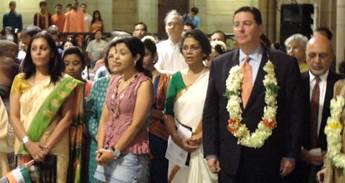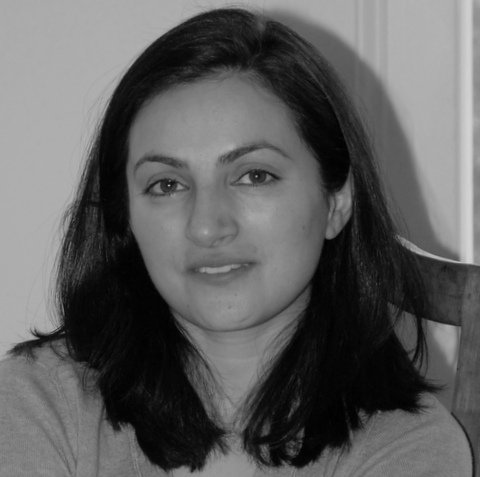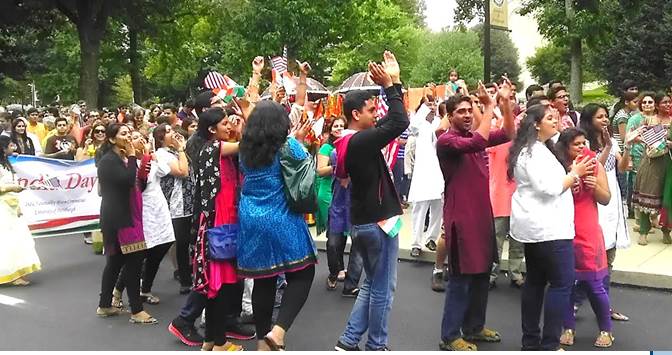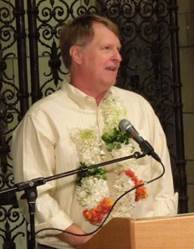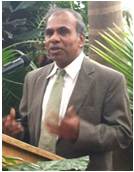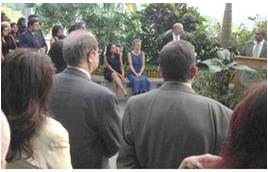Archive for category October 2013
Lead Story: President Obama Buys Time & Averts a Crisis
Posted by admin in October 2013 on September 29, 2013
By Kollengode S Venkataraman
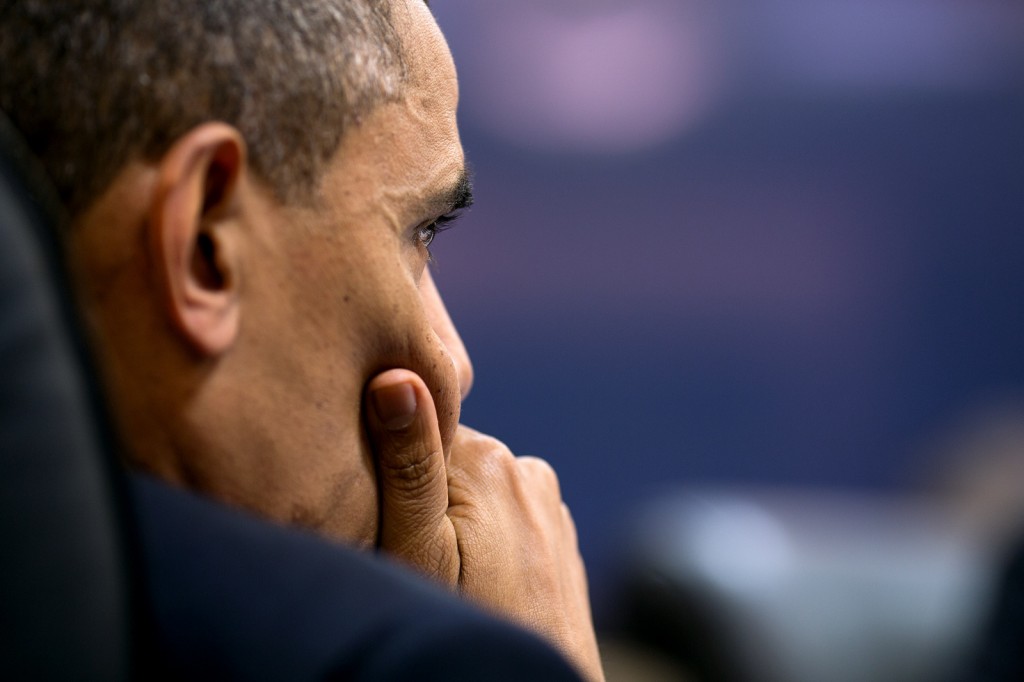 In his talk to the nation on September 10 President Obama, recognizing the lack of support, wisely asked the Congress to postpone the vote granting him the power to attack Syrian President Assad for using chemical weapons on his citizens. President Obama opted instead to use the opening Russia gave that seeks to disarm Syria without US military attack. This buys Mr. Obama time to think through all possible fallouts of such a unilateral and limited surgical missile attack by US forces with “no-boots-on-the ground.â€
In his talk to the nation on September 10 President Obama, recognizing the lack of support, wisely asked the Congress to postpone the vote granting him the power to attack Syrian President Assad for using chemical weapons on his citizens. President Obama opted instead to use the opening Russia gave that seeks to disarm Syria without US military attack. This buys Mr. Obama time to think through all possible fallouts of such a unilateral and limited surgical missile attack by US forces with “no-boots-on-the ground.â€
It is not even clear who used the chemical weapons—the Syrian military under Assad’s orders, rogue Syrian military officers or the rebels.
The US record on matters of chemical weapons is not all that clean. We turned the other way when Saddham Hussein used chemical weapons against Iran in the 1980s. In the 1960s and 70s, in Vietnam US used napalm bombs on nonmilitary targets with devastating effects, and sprayed defoliants over large areas of forests and farm lands—a form of chemical warfare—whose effect was tens of thousands of Vietnamese women delivering babies with grave abnormal deformities.
George W. Bush had with him the tenuous Coalition of the Willing in his war against Iraq when he did not get the UN support. Now Obama was about to become the missile-slinging Lone Ranger planning an attack on Syria in what he calls a surgically precise, short-duration aerial combat. He had no support from other nations (including the “special relations†Britain), the UN Security Council, US Congress or the American public.
Rationalizing his resolve for a military assault on Syria, Obama also said, “[G]overnments representing 98 percent of the world’s population said the use of chemical weapons [is] abhorrent.â€Â If nations representing 98% of the population have signed the treaty against chemical weapons, why does the US representing only 5% of the world population have to go alone? Where are the nations representing the remaining 93%—the Arab League, our Persian Gulf and NATO military allies, Saudi Arabia, Turkey, and Iraq where we waged a 10-year war with almost 4,500 dead US soldiers, over 30,000 wounded soldiers requiring care for the next several decades, not to speak of the several hundred thousand Iraqi civilian deaths? And the Iraq war cost us over a trillion-dollars so far. After all, our Arab military allies and friends in the region have been benefitting by the American military involvement there without spilling a drop of their own blood.
Just because Mr. Obama drew the red line arbitrarily, he wants the war-weary Congress and the citizenry to support him for one more military adventure in a region where US blood has been spilling for over 10 years, and where our credibility is already low. Is this how the leader of the Sole Super Power should go about making decisions on war?
Oh, by the way, we will exceed our debt ceiling in the next several weeks, and the federal government is already in sequestration, we are barely out of a deep economic downturn with anemic new job growth, and we have mounting budget and trade deficits; and we have to take care of so many domestic problems we have been neglecting for over 15 years.
To understand the conundrum of the Syrian Situation and how intractable the Middle East is, go here. Do we really want this war?  ♦
Bill Peduto Slated to be Next Mayor Pittsburgh
Posted by admin in October 2013 on September 29, 2013
By Kollengode S Venkataraman
With a 4:1 voter advantage for Democrats, Bill Peduto, the Democratic mayoral candidate and a member of Pittsburgh City Council, is expected to win easily in November. Peduto won easily in the Democratic primary in Spring 2013 defeating his main rival Council President Jack Wagner in a 4-way primary. The last time Pittsburgh had a GOP mayor was in the 1930s!
Peduto has name recognition, political savvy and gravitas, a good grasp of the region’s politics and economic challenges, and a stronger war chest than his GOP rival.
Bill Peduto is familiar to Indian-Americans interested in public life at the city and county levels. Several times we have covered in the past his a presence at the podium in the annual India Day melas at the Cathedral of Learning. He knows the Indian-American Diaspora here only too well. In the photo above, Peduto is with volunteers in the India Day in August 2013.
Peduto’s has been a progressive and also fiscally responsible voice in Pittsburgh City Council. He understands Pittsburgh’s many challenges—city finances, urban revitalization, and retaining existing businesses and bringing new businesses into the city. Another challenge is making Pittsburgh attractive for our young men and women raised here, and for young professionals from outside to move here.
One also hopes the future Peduto administration will make it easy for suburbanites to come to the city during weekends and evenings to enliven the city’s night life beyond the South Side. One of the biggest annoyances for suburbanites—the region’s population is over 2 million while the city’s is only 300,000—is the exorbitant city parking fees during evenings and on Saturdays. More people coming into the city will revitalize the city’s ambiance during weekends and evenings and expand the city’s retail and hospitality businesses, and help to bring in more tax revenue.
Peduto is endorsed by the region’s political heavyweights—County Chief Executive Rich Fitzgerald, Democratic elected officials and unions. Their goodwill is critical to set the tone of his administration. The influential nonpartisan Common Cause too gave Peduto “The Champion of Good Government†award in 2012. We wish Bill Peduto well.  ♦
The Need to Recognize Depression in Youth
Posted by admin in October 2013 on September 29, 2013
Dr. Mani Balu, Monroeville, PA
e-mail: balus61@gmail.com
Editor’s Note: Dr. Mani Balu is one of the early Indians to settle down in Southwest Pennsylvania. For over three decades he practiced pediatric medicine in Union Town, PA. After retiring from his practice, he and his wife Shantha now live in Monroeville. PA.
On May 27, 2013 we lost our dear daughter Geetha, 35, to depression. She ended her life after suffering from depression for fifteen long years.
This article is not intended to publicize her illness or our grief. As a father and a pediatrician, my aim through this article is to make people aware of depression.
In general, people do not recognize depression in themselves or in their loved ones early. Even if they suspect it, either they neglect it, deny it or think that it is due to some other illness and put the person through many medical tests. As a pediatrician, I see this problem in my patients, when the teenagers are brought to me with symptoms suggestive of depression. When I tell the parents that I suspect depression in their daughter or son, neither have they believed it nor wanted to accept it. As a result of this, the diagnosis and proper treatment are delayed or even denied. I hope this article will help everyone understand the problem and seek medical help promptly.
First of all, we need to understand that depression is a chronic disease due to chemical imbalance in the brain. As of yet, we do not know the cause of this. It is more common in girls. It has a genetic predisposition too. If a parent, grandparent, sibling or other close relative has or has had this problem, we should realize there is more chance for the youth to have depression.
More importantly, as the causes of depression are not known, there are no preventive measures. So please do not feel guilty that you could have done something more to prevent it.
Realizing the seriousness of depression and the importance of its early detection and proper and prompt treatment, the American Academy of Pediatrics has instructed all pediatricians in the United States to ask the following questions to all girls and boys between the ages of 15 and 18 years to diagnose the condition early, during their yearly physical check ups. (Depression can start earlier or later also.)
- Do you have little interest or pleasure in doing things?
- Do you feel down, depressed, irritable or hopeless?
- Do you have trouble falling or staying asleep?
- Do you feel tired or have little energy to do things?
- Are you experiencing poor appetite, weight loss, overeating or weight gain?
- Do you feel bad about yourself or feel you are a failure or have let yourself and your family down?
- Do you have trouble concentrating on things, such as schoolwork, reading or watching TV? Do you avoid friends and prefer to be alone most of the time?
- Do you move or speak so slowly that other people notice OR conversely, are you fidgety, restless and worried all the time?
- Do you have thoughts that you would be better off dead or would like to hurt yourself in some way?
Hopefully this article will help in the early diagnosis and prompt treatment of someone who may be suffering.
As for Geetha, she herself suspected that she might have depression when she was living in the college dorms and she told me about it. The diagnosis was confirmed soon and the treatment was started promptly.
For fifteen long years, she had all kinds of treatment: Allopathy, Homeopathy and even Tirupati (Venkateshwara). Hers was a severe case of depression which took her away from us.
I still feel confident that, in the future, we will have a better understanding of the disease with better outcomes. So please, do not give up hope. ♦
Miss America Pagent 2013 — American Identity, Always a Work in Progress?
Posted by admin in October 2013 on September 29, 2013
 By Kollengode S Venkataraman
One can deal with people who are ignorant but not arrogant — we can inform them.
One can deal with people who are arrogant but not ignorant — we can level with them.
But it is difficult to deal with people who are both ignorant and arrogant.  And people who are both ignorant and arrogant are in all demographic groups and subgroups.
Add hate to this combination and you have a combustible mix.  All it needs is a simple trigger. A few days after September 11, 2001 a pack of young men screamed at my daughter, “You Arab, go home,â€Â at Miracle Mile Shopping Centre’s parking lot in Monroeville, a Pittsburgh suburb.  My daughter in her early twenties then and a quintessential product of the social and education system here shouted back, “I’m Indian, you moron!â€
It happened again after the Indian-American Nina Davuluri, born and raised in the US, was declared Miss America in the pageant. She was the first Indian-American to get this title. Granted, beauty pageants, mercifully have lost their luster in many parts of the world. These days, increasingly brains – not beauty defined by the multibillion dollar fashion industry in the Western world – is the yardstick coveted by young women everywhere. Thank Almighty God for this change.
No sooner than Davuluri got the title, social media was lit with racist comments steeped in ignorance, arrogance, and hatred. Here are the samples reproduced verbatim (including profanity and grammar mistakes):
- And the Arab wins Miss America. Classic.
- How the f@#$ does a foreigner win Miss America? She is a Arab!
- 9/11 was 4 days ago and she gets miss America?
- Miss America right now or miss Al Qaeda.
- Congratulations Al-Qaeda. Our Miss America is one of you.
- So miss America is a terrorist.
- Miss America? You mean miss 7-11.
- Miss America, footlong buffalo chicken on whole wheat. Please and thank you.
- Man, our president nor our new Miss America isn’t even American…
True to the American spirit, one must also acknowledge, a whole lot of people were also aghast at these comments as one could see in the readers’ response to these comments.
Going beyond these external responses, there is a larger and more important message to Indians living in different parts of the world: For Indians – and Indian-Americans — obsessed with equating beauty with pale, “wheatish†complexion, the choice of Nina Davuluri with her dusky chocolaty complexion would have come as a rude shock, which, in due course of time, I hope, would evolve into a revelation and self-discovery.
After all, traditionally Indian classics always describe dark skin tone in luscious and sensual terms. Shyama-sundari, common name for women, literally means in Sanskrit “a dark-complexioned beautiful young woman.†Shyamali is also another common name for girls. Shyam-sundar is an affectionate epithet for Krishna, literally meaning “a dark-hued handsome young man.â€Â Saraswati, the Hindu Goddess of knowledge and fine arts, is dark-complexioned — kaar mukil meni in Tamil — as described in one of the prayers.
One hopes Davuluri’ s choice slowly reverses the trend among both young and older Indians’ perception of beauty that  forces young Indian women to apply Fair and Lovely, the peroxide-loaded chemical bleach to look pale, which leads to all kinds of skin problems.
Now that the Gora Duniya of USA, by selecting the Kali Desi Nina Davuluri as Miss America, has acknowledged that a darker skin tone (shyama) is just as beautiful, one hopes that Indians in India and even Indian-Americans here will start seeing beauty in their countless natural shades of darker skin tones – Like Indians running to yoga studios and meditation retreats after the Caucasian world acknowledged their merit. ♦
Working to End Violence Against Women
Posted by admin in October 2013 on September 29, 2013
By Namita Luthra, New York, NY. Â
e-mail: namitaluthra@gmail.com
Editor’s Note: Namita Luthra, a civil rights lawyer, lives in New York City with her husband Anil Shrivastava and their two children, Amartya and Jaya. She grew up in Weirton, WV, near Pittsburgh.
“Everyone deserves love, laughter, and joy in their lives. No one deserves to live in fear.†— Radha, a survivor of domestic violence.
To end violence against women. That is the simply stated but ambitious mission of Sakhi for South Asian Women, an organization founded twenty five years ago in New York City that assists survivors of domestic violence. Sakhi, meaning woman friend in Sanskrit, takes a two-pronged approach to achieving this mission:
First, it creates a safe place with a full range of culturally sensitive, language-specific information, support, services, and advocacy for South Asian women facing abuse in their lives.
Secondly, it works to inform, actively engage, and mobilize the South Asian community in the movement to end violence against women forever. Though its mission is far-reaching, Sakhi works to make it a reality one woman at a time.
In 2012, Sakhi served nearly 600 women who reached out through its helpline, website, or a referral. Here is a glimpse of one life of a survivor named Radha, in her own words:
“Growing up, my home was filled with laughter, love, and joy. My parents were like normal Indian parents and expected the best from us in terms of grades, manners, and respect, but they always made us feel cherished and supported
Even on my wedding day, my mom held my hand before I walked towards the mandap and told me that she would always support my decisions and always stand by my side.
After I married, my home was filled with sadness, disrespect, and fear. My husband ruled the home like a tyrant and used his words and hands to instill fear in me. He wouldn’t allow me to see family or friends. And soon I was isolated, alone, and afraid.
Sakhi helped me move past my assumptions that I would shame my family and, society would view me poorly if I were divorced, and helped me move forward in my life. Sakhi helped me get a lawyer and held my hand in court. My mom stood by her word and held my other hand.Â
I am now happily married to a wonderful man and have two very loved children. With the support of Sakhi and my loving family, my home is filled with laughter, love, and joy once again.â€
My own involvement with Sakhi is a longstanding one. In 1996, after receiving a law degree from the University of Pittsburgh School of Law, I moved to New York City for a civil rights legal fellowship with the American Civil Liberties Union. At the same time, I began a volunteer position with Sakhi. As a volunteer, I helped survivors of violence navigate the criminal justice and civil law systems. In 2012, I joined Sakhi’s Board of Directors and now help set its development and program priorities.
At Sakhi’s helm is Tiloma Jayasinghe, its Executive Director, who has steered Sakhi in bold and new directions. In addition to strengthening its local focus, Tiloma now ensures Sakhi’s role in a national and global conversation about reframing anti-violence work.
Other vital members of the Sakhi team include Community Outreach and Domestic Violence Program Advocates and an Economic Empowerment Coordinator. This spring, Sakhi along with other South Asian women’s organizations, was present for President Obama’s signing of the reauthorization of the Violence Against Women Act. Two years ago, Sakhi hosted a summit for international and national social justice leaders to understand intersections between immigration, economic dependence, and gender violence and set forth positive goals for the movement.
This year, Sakhi celebrates its 25th Anniversary. It marks this milestone with several events during the year including a gala reception in May 2014. In past galas, Sakhi has honored dedicated supporters including film director, Mira Nair, a United Nations Special Rapporteur on Violence Against Women, and most recently this May, Ann Mukherjee, Senior Vice President of Frito Lay, who spoke compellingly about her own history of surviving violence.
Sakhi could not exist without generous support from a committed South Asian community in the New York metropolitan area. The Pittsburgh and Tri-State South Asian community can contribute to Sakhi’s vital work, too. A contribution from you, no matter how large or small, will help Sakhi achieve its mission – one woman at a time. Join our mailing list to learn more about Sakhi’s important work, receive updates about 25th Year events, or support Sakhi, by contacting Danielle Reydon through Sakhi’s website: www.sakhi.org. By supporting our work, you could take pride in helping to end violence against our fellow sakhis – Indian, Pakistani, Sri Lankan, and other South Asian women. Women like Radha. ♦
The India Day Celebrates Everything Indian
Posted by admin in October 2013 on September 29, 2013
By David Downey  Â
e-mail:Â : DPD25@pitt.edu
Editor’s note: David is a senior at the University of Pittsburgh majoring in Philosophy. He also works at the Nationality Rooms Program. David hopes to see more India-related events.
On Sunday, August 18, hundreds of people gathered at the Cathedral of Learning on the University of Pittsburgh campus. Although the sky was overcast, smiles were everywhere as people prepared for the 16th India Day’s festivities, celebrating India’s culture, heritage and ancestry coinciding with the 66th anniversary of India’s independence. This year’s festivities highlighted Subhash Chandra Bose.
The festival began outside with a parade around the grounds of the Cathedral with Keerti Gaulati welcoming crowd and singing the Indian and American national anthems. A truck carried powerful speakers that put forth both Indian music and the rallying words of the parade. The music was accompanied by a variety of hand-held percussion instruments, as well as the cheers of marchers and spectators with the marchers in the front spontaneously dancing to the upbeat tunes. The half-hour parade drew several pedestrians into the Cathedral to see what was going on.
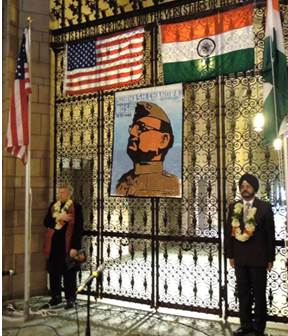
University of Pittsburgh Chancellor Nordenberg and Indian Army Brigadier (Retd) Nawab Singh Heer after the flag hoisting.
The program booklet was a work of art in itself, with messages from leaders in Pittsburgh’s community, a summary of the life of Netaji Subhash Chandra Bose, a timeline of India’s history, and advertisements for Indian restaurants and businesses.
Although many festival goers were dressed casually, many others wore traditional dress with many women in brightly colorful saris. The extravagant ornamentation of the dresses brightened the grey limestone halls of the old Gothic building. The Commons Room became even more lively as music and dance performances alternated with speeches.
The two-hour program started with people singing the American and Indian national anthems as the Stars and Stripes and the Indian Tricolor flags were hoisted. People celebrated their freedom to exercise both Indian and American identities, and how cultures are able to celebrate and complement each other. Speakers included Chancellor Mark Nordenberg, Councilman Bill Peduto, County Commissioner Rich Fitzgerald, Meena Muthyala, Kaushik Mitra, and Chelsea Pallatino.
Speeches addressed everything from Indian history and freedom, making a new home in Pittsburgh and the US, climate change, and maintaining a rich cultural heritage and working together as a community.
These elements are all exemplified by the Indian Nationality Class-room on the third floor of the Cathedral that
was opened in early 2000. The classroom cost tens of thousands of dollars raised by the Indian community in the region. The dedication required to build a classy teaching room is proof that the speakers’ words rang true. The room was open to visit, and many took time to appreciate its representation of the ancient classroom.
The classroom also continues to give, as made clear by the speech by Chelsea Pallatino, this year’s winner of the Indian Nationality Classroom Scholarship, which enabled her to travel to India. Chelsea worked with Share India to assist health issues in the Medchal Mandal area. This experience allowed her both to experience rich Indian culture, and give back to those people by improving health conditions. The dances and songs performed by various ages kept the festival atmosphere alive.
In addition to the speakers and dancers in the center of the room, various tables lined the perimeter. There were several arts and crafts tables for children, with people indulging in the Indian food available. There were multiple booths inviting philanthropy. These were hosted by Overseas Volunteers for a Better India, The Association for India’s Development, and The Bengali Association of Pittsburgh. The event was also sponsored by The U.S. India Forum. Finally, there was a table selling finely decorated saris, and another selling books. The books covered biographies, history, religious scripture and meditation practices.
The effort and planning required for an event such as this were no challenge for the motivated enthusiasts of Indian culture and heritage. ♦
A Very Unusual Last Goodbye
Posted by admin in October 2013 on September 29, 2013
By Cindy Koller, West Newton, PAÂ
e-mail: ckoller@andrew.emu.edu
Note: Cindy Koller proofreads and copyedits most of the articles in the Patrika. When you still find typos here and there, it is because we did not send those articles for her critical look on account of time constraints. — Editor
Just recently my husband’s cousin Ernie died. Ernie was 96 years old and died while doing one of the things he loved most—working in his garden. A long life lived well to the very end. Ernie leaves behind Rose, his wife of 59 years; five children; eight grandchildren and a great-grandchild, as well as many nieces, nephews, cousins and friends.
Plans for Ernie’s funeral and burial were well-thought out and pro-ceeding well until the unimaginable happened: the day after Ernie died, Rose fell and broke her hip. This required immediate hospitalization and surgery. Rose was already distraught at Ernie’s unexpected passing.
But now, being unable to attend the viewings, funeral services and burial were causing Rose and her family a great deal of emotional pain.
Well, if Mohammed couldn’t come to the mountain, the mountain would have to come to Mohammed. And come it did.
Through an incredible act of care, compassion and cooperation, the funeral home and the hospital devised a plan. After the viewings and church service were over, instead of proceeding directly to the cemetery, the hearse journeyed to the professional building attached to the hospital where Rose was a patient. A room there was arranged as a make-shift funeral parlor. Ernie’s casket was brought in and re-opened and his body was gently prepared for an ‘encore’ viewing by his wife.
When all was ready, Rose arrived in a wheelchair to have her final visit with Ernie and take her leave of him. Family, pall-bearers and close friends were invited to attend this special viewing.
After Rose gently scolded Ernie (“You know I was supposed to go first!†she said to him) and expressed her parting thoughts, all the rela-tives got in line to greet Rose and take one last leave of Ernie. She talked and visited with each person.
With this unusual arrangement, Rose got that all important closure that would have been denied her had the funeral home and hospital stuck to rigid formalities and policies.
This generous act of humanity and cooperation afforded a grief-stricken widow and her children an opportunity for closure and peace. It was our privilege to have been able to participate. And it is a testament to both the hospital and the funeral home that they bent a few rules to provide comfort and solace to this family in their time of grief.  ♦
Are There Any Truths in Mythological Stories?
Posted by admin in October 2013 on September 29, 2013
By Kollengode S Venkataraman
There was a story by Laurie Goodstein in the July 20th issue of The New York Times (http://tiny.cc/Mormon_Doubt) focusing on an intrafaith challenge: When Mormons search the web for reinforcement and clarifications in their faith, they end up with doubt and disillusionment because of the historical anomalies, inconsistencies and church practices between what they hear in their tightly managed churches and read in the Mormon Bible, and what is widely available on the Internet.
Goodstein quotes a deeply religious Mormon overseeing the Mormon Church’s European operations: “I felt like I had an earthquake under my feet. Everything I’d been taught, everything I’d been proud to preach about and witness about just crumbled under my feet. It was such a terrible psychological and nearly physical disturbance.â€
A few days later, Harold Kushner, a Conservative Rabbi and the author of the bestseller When Bad Things Happen to Good People, chimed in advising Mormons on how Judaism deals with inconsistencies in its Bible, the Old Testament, compiled a few thousand years before the Mormon Bible’s time (Letter to The New York Times, July 23). The rabbi writes:
“Might I suggest that they [Mormons] use the tactic used by many modern Jews dealing with biblical narratives that defy credulity, from a six-day story of creation to Jonah living inside a large fish. We [Jews] distinguish between left-brain narratives (meant to convey factual truth) and right-brain narratives (meant to make a point through a story).â€
The rabbi goes on: “The message will be true even if the story isn’t factually defensible.†Modern Jews’ efforts to reconcile credulous events in their Bible with their skeptic members today are understandable.
In this background, we hope—and also expect—that the Abrahamics extend the same approach when they study mythologies in other systems of beliefs instead of showing condescension and derision.
In any case, there is nothing “modern†or original in modern Jews’ attempt to reconcile the incredulous with the cerebral. In fact, this is the very basis of stories in Indian and Greek mythologies, and in the Sufi stories that came over 1500 years later. In all these stories, even when the narratives themselves are incredible and truly fantastic, the kernel messages they convey are valid for all times and in all places.
So, here is an example of a story I heard in the Bhagavatam discourse by Shantananda at the Chinmaya Mission in August:
In the Hindu cosmology, time is divided into four sequential yugas or epochs, called the Satya or Krta, Treta, Dwapara, and Kali yugas, with each yuga thousands and thousands and thousands of years long. But that is not important here.
In the Satya Yuga, the noble and the evil people lived isolated in different worlds. In the Treta Yuga (Ramayana’s time), the noble and evil people came closer—in different land masses on earth separated only by water. The noble Rama was in India and the evil Ravana in Lanka, separated by water. In Dwapara Yuga, the evil and noble people became closer still—cousins of the same family, as the noble Pandavas and the evil Kauravas. In the Kali Yuga (our time), the Noble and Evil are the closest they can ever be—the two are in all of us in our own mind. As ideas and thoughts, the two constantly battle each other all the time each trying to have an upper hand within each one of us. ♦
Running in a Marathon Changed My Life
Posted by admin in October 2013 on September 29, 2013
Paul Grossi, Beaver, PAÂ Â Â Â Â e-mail:Â Â paul.grossi@hotmail.com
Editor’s Note: Paul Grossi works for a small global company. While working full time, he earned his BS in Business Administration from Penn State and went on to earn his Masters in Project Management & Leadership from Geneva College.I never had any interest in running; it never appealed to me. But some years back, my life and health was headed in the wrong direction and out of balance. I was going to school and working full time. I had a stressful, sedentary lifestyle. I was challenging and pushing myself mentally but doing nothing physically. I was putting on weight, and at the age of 35, I set a goal to run my first marathon and attempt to turn my health around.
A marathon is a 26.2-miles-long endurance test. The first marathon I attempted was the Pittsburgh Marathon in 2010. I underestimated the challenge and didn’t train well. I just thought I would do the best I could and coast to the end post.
I quickly discovered that running in a marathon was one of the hardest things I had ever attempted. It rained nonstop the entire race and the most difficult part was finishing the last six miles. My body, and more importantly my mind as well, were not prepared for the difficult challenge. I did however complete the marathon in 5 hours and 46 minutes. Crossing that finish line and accomplishing a goal I had set for myself encouraged me to improve and do better.
Shortly after, I joined Steel City Road Runners, a great community of runners in Pittsburgh. They were a very good support group and didn’t care how fast or slow you ran. I found people faster than me and people slower than me.
I began entering smaller races, 5K’s to 10K’s, and doing weekly training runs with the new group. I really enjoyed running with them. They motivated me to keep running and not give up.
The group began putting training plans together for various races and marathons. A plan for a marathon consists of 16 to 18 weeks of training in which you increase your mileage every week, and have one long run on weekends. Ultimately, the longest weekend run increases to 20 miles, and then you are ready for the marathon.
I learned about the importance of pacing, not starting too fast and taught myself not to give up mentally. I also learned the importance of hydration, stretching, and how to recover after a long run.
Since the 2010 Pittsburgh marathon, I have completed five full marathons. I’ve improved my time by about 20 minutes on every race. My current fastest marathon time is 4 hours and 3 minutes. I do plan to run many more marathons in the future, maybe even a few ultra-marathons. My ultimate goal is to qualify for the Boston marathon next year in which my time needs to be under 3 hours and 15 minutes.
I found that the best thing you can do is surround yourself with a community of supportive and encouraging people that share the same goals. For runners this supportive community helps continually motivate you to  become better. Running a marathon is as much a mental challenge as it is a physical challenge. Running makes you mentally strong and teaches you not to give up when things become tough.
Running in a Marathon is a great metaphor for life. In life, just like when running, there will be some tough times. Everyone has to decide whether to give up when things get tough, or to keep moving through the difficult times. During these tough times, we test ourselves and find out how strong we really are and what we are really made of.
Running is not about distance alone—it’s about setting personal goals, challenging yourself and seeing what you are capable of accomplishing. Whether you run a full marathon, or a 5K, or however fast or slow you are, it’s all about reaching your goals and continually working to get better.
It’s a blessing to be able to get out and run every day. You can enjoy the outdoors, get away from problems and set goals for yourself. Most people don’t know what they are capable of until they begin to set goals and start accomplishing them.
Running has changed my life bringing me balance and happiness. I can get away from the stresses of the day and relax during running. It’s my time to think clearly and cope with any issue. I do my best thinking when I’m running and am always in a better mood after a run. Running has improved my health and has brought many other positive changes into my life. I feel that I have become a stronger person because of running.
I recommend running for anyone that has a busy schedule and wants to improve their mental and physical health. Running is by far the easiest, cheapest, and fastest way to improve your mood, your health, and outlook on life. Running has improved my life in so many ways. It has energized me and given me a new outlook on life. I’m happy and excited to call myself a runner. ♦
Dr. Subra Suresh Shares His Vision for CMU in a Reception at Phipps
Posted by admin in October 2013 on September 29, 2013
By Kollengode S Venkataraman
Striving to keep the technological edge it has cultivated over the decades, significantly strengthening endowments for its long-term stability and growth, and aesthetically embedding motifs of performing and visual arts throughout the campus are on the “To-Do†list of Dr. Subra Suresh, the new President of Carnegie Mellon University (CMU). The last one is not trivial. CMU’s College of Fine Arts, though among the best in the nation, is often overshadowed by its techie image among the general public.
Dr. Suresh shared these points in his freewheeling remarks in the reception given to him at the Phipps Conservatory on Tuesday August 27 by Sunil & Nita Wadhwani on behalf of Pittsburgh’s Indian-Americans. Mr.Wadhwani is on the governing board of CMU. The 200-plus invitees represented Indian-Americans of diverse background.
After his 3-year tenure as the head of the prestigious National Science Foundation, whose mandate is to identify and fund the advanced research needs in all branches of science, Dr. Suresh is now at the helm of Carnegie Mellon. As Sunil Wadhwani said in his opening remarks, CMU gives its presidents long tenures—in CMU’s over 100-year history, Dr. Suresh is only its ninth president.
Dr. Suresh, the first India-born scientist to head a major cutting-edge US university, has ambitious goals even as he recognizes the competition from other big players. After all, he was at MIT and Brown University teaching and in research and administration as well.
In his unscripted easygoing remarks, Dr. Suresh also touched on the reasons for the high cost (~$45,000/year) of undergraduate education in private universities—not eligible for any state grants, and daring to pursue cutting edge research that state legislatures will not be interested in funding. Ironically, he said, these cutting edge researches spawn multi-billion dollar industries employing thousands while keeping the US as the technology leader. But this is little comfort for a family of four with an annual taxable household income of $50,000.
One question to him from the audience was whether CMU will open a campus in India as it and other
universities have done in other nations. The gist of Dr. Suresh’s answer was: Opening an off-shore campus is one of the ways, certainly not the only way, in which CMU can strengthen education in India. Outside the US, he said, India has the largest number of CMU alumni in universities, industries, and in R&D. CMU can innovatively capitalize on this soft resource without opening an Indian campus, to have an impact on technical education in India while also benefitting CMU.
He did recognize that a $45,000/year CMU campus in India would be over Rs.2.5 million (Rs. 25 lakhs) per year in school fees, a huge sum.
We can see his point. This will not sit well. In India even for working people with college degrees, the family income would be only round Rs. 600,000 (Rs.6 lakhs) per year, not to speak of India’s working poor.
Suresh, accompanied by his wife Mary, a public health professional with her own credentials, spent the reminder of the evening getting to know the Indian-American community in town. The canopy of the Phipps’s live exhibit of the Tropical Forest India, provided a perfect ambience in every measure—brightly sunny and humid with temperatures in the 80s.
The Taj Mahal Restaurant provided the catering for the reception.
Swami Vivekananda: His Influence in America
Posted by admin in October 2013 on September 29, 2013
By Dr. Prakash C. Mullick, Pittsburgh, PA
This year India and many parts of the world celebrated the150th anniversary of one of the greatest religious leader and philosopher of Hinduism. Vivekananda was invited as a speaker of Indian religion at the world’s Parliament of Religion held in Chicago in 1893. The topic of the conference was unification of all religion into a Universal religion.
He was the last speaker on the first day, at the time when attendees were preparing to leave. However, when Vivekananda stood on the podium and addressed the parliament, “Brothers and Sisters of America,†those in the audience were stunned, and turned to listen to him. He spoke very clearly and said, “If there is ever to be a Universal Religion, it must be one which will have no location in place or time, which will be infinite like the God it will preach, and whose sun will shine upon the followers of Krishna and Christ, on saints and sinners alike; which will not be Brahminic or Buddhist, Christian or Mohammeden, but the sum total of all these, and still have infinite space for development.â€
He spoke powerfully about Indian religions and Hinduism. He explained the universal principles which form the foundation of Hinduism, such as the divinity of the soul, self-realization and eternal peace as explained in Vedantic principles that he grasped from his Master Sri Ramakrishna.
He told the parliament that the Hindus are open minded and embrace all the religions of the world, and explained the true religion as “eternal truths and the laws of the spiritual world,†namely, Vedanta. He introduced India as the spiritual leader of the world. From that time onwards people in the West and America came to know the worth of India and to develop a quest for spiritual knowledge.
Vivekananda was declared as the chief architect of the parliament by the Chairman of the Congress and people followed him all through his lectures on different topics and became his ardent followers. The New York Herald wrote, “He is undoubtedly the greatest figure of the Parliament of Religions. After hearing him we feel how foolish it is to send missionaries to this learned nation.â€Â The Boston Evening Paper wrote, “He is a great favorite of the parliament by his sentiment and appearance. If he merely crosses the platform, he is applauded.â€
Swami Vivekananda was born in Calcutta in 1863, graduated from Calcutta University with majors in Philosophy, History and Music. Perturbed with the poverty and backwardness in India, he questioned God until he met his Guru Sri Ramakrishna, who gave him direction and imparted to him spiritual knowledge.
Ha!
Posted by admin in October 2013 on September 29, 2013
Try Understanding the Middle East Conundrum
President Obama avoided military action in Syria by buying time for diplomacy for removing chemical weapons in Syria. The unilateral and go-it-alone US Military action would have damaged the American interest in that region even further from where we stand now, which is pretty low.
One Mr. K. N. Al-Sabah helps readers of The Financial Times to understand Middle East politics thus in his letter to the editor in August:
“Iran is backing Assad [of Syria]. [Persian] Gulf States are against Assad. Assad is against Muslim Brotherhood [in Egypt], and Obama is against General Sisi [of Egypt].
But Gulf States are pro-Sisi! Which means they are against Muslim Brotherhood.
Iran is pro-Hamas, but Hamas is backing Muslim Brotherhood!
Obama is backing Muslim Brotherhood, yet Hamas is against the US!
Gulf States are pro-US. But Turkey is with Gulf States against Assad; yet Turkey is pro-Muslim Brotherhood against General Sisi. And General Sisi is getting backing from the Gulf States.
Welcome to the Middle East and Have a nice Day.â€
Naming Rights, Desi Ishtyle
In the US corporations spend millions of dollars for naming rights for stadiums and auditoriums, and individuals pay millions to universities to get the buildings and departments named after themselves. One city in India has adapted this feature with a uniquely Indian twist. Citizens of Raipur, the capital of Chattisghar state in Central India, have given to themselves the rights to name potholes after elected public officials to show their annoyance.
Angered at the potholes (gaddha in Hindi) on Raipur roads, citizens came up with a novel way to protest—naming potholes after elected officials. Now they have Brijmoham Gaddha (named after the public works minister), Raman Gaddha (after chief minister), and Munat Gaddha (after environment minister).
They also solemnized the event in different parts of the city with the namakaran (naming) ceremony with proper rituals with help from priests.
Probably they know that the potholes will never be filled. The priests could as well have uttered sotto voce the traditional Deerghayushman-bhava (may you have a long life) after the naming ceremony.

